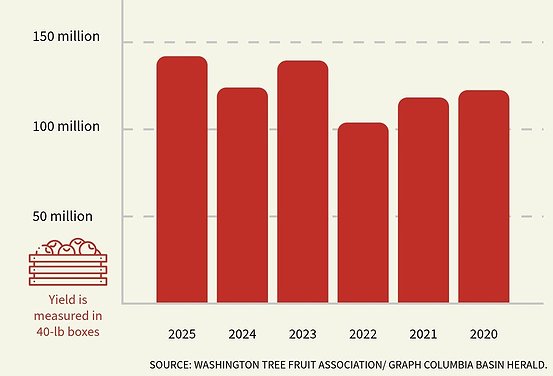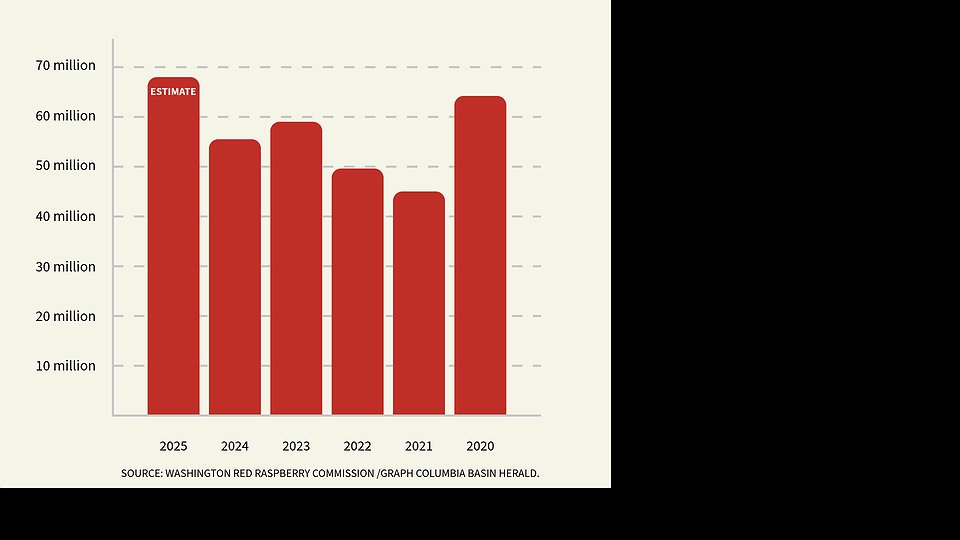Good harvests for for potatoes, apples, wheat and raspberries in 2025
MOSES LAKE – With fall in full swing, growers around the area are either completing their harvests or are on the verge of harvesting all their produce for the season. This year potatoes, apples, wheat and raspberries around Eastern Washington are all on track to see a successful output.
Potatoes
Eastern Washington’s potato varieties had a strong growing season this year. Chris Voigt, Executive Director at the Washington Potato Commission, said this year lacked any extended periods of heat and overall had ideal weather conditions for potatoes.
“Just the entire growing season has been really good,” said Voigt. “It’s really kind of set up for a nice harvest season.”
The harvest season for potatoes started out warmer than usual which caused a delay since harvesting potatoes in hot weather can harm the potatoes when they are transferred into cold storage, said Voigt.
“We could harvest potatoes in the morning, but then we’d have to shut down as we got closer to noon or afternoon, just because the temperatures got too high,” he said.
As the season moved into late September and early October, the weather cooled off significantly which has led to perfect potato harvesting weather for the remainder of the season.
The 2024 crop was reported to have a yield of around 10 billion pounds of potatoes and Voigt said this year’s yields are looking to either meet or exceed that amount. For some of the early-season varieties of potatoes, there was a 10-20 percent increase in yield, and the later-season varieties are expected to have slightly above average yields.
Voigt said that Washington state has the highest yields of potatoes in the world, and that is due to the length of the growing season, particularly in the Columbia Basin, where potatoes are planted in March and harvested in October.
The Columbia Basin’s soil content and desert climate also provide an ideal environment for potato growth. Being in the Pacific Northwest also brings longer days and strong precipitation in the cooler months and a lot of sun in the summer.
“That’s really what makes growing potatoes here in Washington state so special and why we’re so good at it,” said Voigt. “Just all of those environmental factors really line up for us.”
Along with a strong supply, the potatoes are also of high quality this year.
“Probably some of the best quality we’ve had in a long time, again, just because it was such great potato growing weather all season long and it’s coming to a great harvest season too,” he said.
Potato farmers had a decrease in acreage this year, down from 165,000 acres in the state to 145,000. Voigt said while this might mean production might be down this year, the overall crop is looking good.
“It’s going to be a strong potato year and consumers have a lot to look forward to,” he said.
Apples
The Washington apple harvest is in full swing, with the process beginning in the first week of August and lasting until late November, said Jon DeVaney, president of the Washington State Tree Fruit Association.
“We’re now at the point where we can get an indication of how the early harvested varieties compared against the crop forecasts that the industry generated at the start of harvest,” said DeVaney.
What has been seen from the varieties that were harvested early in the season is that there has been a reduction from what was originally forecast. He said this reduction was due to the high heat throughout August and districts having decreased water supply during the season and that they were projected to be near their previous record of apple production.
DeVaney said growers who had a lot of expensive harvesting and had some challenges with pricing the past couple of years opted to be more selective on what they picked this year.
“Both for those quality reasons of fruit stress by August heat and to make sure that they were picking only the fruit that was going to fare best in a pretty abundant market,” he said.
For early season varieties such as Honey Crisp, Gala and Golden Delicious, there was about a 5.6 million box reduction from what was forecast, according to inventory reports from packer members at the beginning of October. Devaney said this report is still subject to change over the next couple of months as packers learn more about the apples in storage.
Later-season varieties are projected to have been less affected by the August heat, but ongoing effects through the end of harvest, such as temperature and precipitation, can still impact the fruit as they grow closer to maturity.
“You want to make sure that you get some cool evenings and overnight temperatures as well as some warm weather and sunshine during the day so that you have the development of size and color towards the end of the growth period,” said DeVaney. “And then favorable weather for harvesting.”
DeVaney said the overall decrease in the crop is actually welcome this year as the market has not been strong and it makes the harvest seem like more of a manageable task to manage a crop that is more of a typical size.
Growers this year have also been sharing data on how much fruit they’ve had on their farms, which allowed them to make choices about which fruit would be best suited for the current market, he said.
“The fact that the growers are being selective about not picking (stressed fruit) and the packers are going to be selective about bringing only the best fruit to market means that we’re still going to have a very abundant apple crop and the fruit that is going to be sent to consumers is going to be that of the highest quality,” said DeVaney.
Wheat
This year’s wheat harvest has already reached completion with the winter wheat being 100% harvested by September 2 and the spring wheat being 100% harvested by September 21 according to the USDA’s Crop Progress report.
“Overall, winter wheat performed well, while spring wheat struggled under challenging conditions,” said Washington Grain Commission’s Market Development Specialist, Jake Liening.
The winter wheat varieties benefit from good planting moisture in the Fall of 2024 and was followed by an abnormally wet winter, particularly in January and February, which helped replenish soil profiles before the crop broke dormancy. Liening said the early moisture reserves carried the crop through a dry spring allowing many growers to finish with average to above-average yields.
Spring wheat had a much tougher time this year as there was essentially little to no rainfall in Eastern Washington after spring seeding wrapped up. He said precipitation was limited and scattered from planting to harvest, with growers reporting few measurable rain events during critical growth stages.
This year’s spring wheat crop faced one of the driest April to July periods in recent years. Liening said by mid-summer, only 8% of Washington’s topsoil moisture and 12% of subsoil moisture were rated adequate, while nearly half of all acres were classified as very short on moisture.
“This resulted in below-average yields, particularly across the southeast and Columbia Plateau, where moisture stress and heat arrived early,” said Liening.
Weather is what typically defines a good wheat season, especially when it comes to moisture. He said a wet fall and winter fills the soil profile for winter wheat, and a few well-timed spring rains keep plants happy through June. Having fewer hot days in June during gain fill means better test weight and yield overall.
Planting on time is also key to a successful harvest as well as choosing the right variety to plant for an area. Wheat farmers must also have good conservation practices after harvest to leave residue and minimize soil disturbance to help store winter moisture and reduce erosion in dryland hills.
He said according to the USDA’s 025 Small Grains Summary, Washington produced 141.5 million bushels of wheat in 2025 which is down 1.5% from 2024, but is still 12% above the five-year average. The winter wheat produced 121.7 million bushels, averaging 68 bushels per acre, and the spring wheat produced 19.7 million bushels, averaging 42 bushels per acre.
“While total production was marginally lower than last year, Washington maintained its long-term ranking as the fourth largest wheat-producing state, contributing roughly 7% of total U.S. wheat output in 2025,” said Leining.
Raspberries
Washington raspberries had success this year and saw an overall increase in yield, said Gavin Willis, Executive Director of the Washington Red Raspberry Commission.
“The last couple of years volumes have been down and it seems like they’re trending back up,” said Willis.
Last year’s total volume for red raspberries in Washington state was a little over 55 million pounds. He said the production reports from fruit processors around the state are still in the works, but this year’s total production is on track to be in the range of 68 to 70 million pounds, which will be the highest harvest since 2018.
Ideal weather throughout the year was the leading factor in the success of raspberries in the state. Willis said the raspberry plants had a good bloom window for pollination in the spring, and through the summer and into the harvest season there were plenty of clear days to help maintain fruit quality.
“What can happen some years is you get precipitation followed by overcast weather which keeps a lot of moisture in the fields and leads to issues with fruit quality,” he said. “What we saw this year is those instances during the summer where we did have rain, we’d have the sun out the next day to dry the fields out.”
Growers have also brought in a couple new varieties over the last couple years which are starting to come into production this year with good yields. Willis said growers have had to get used to the characteristics of some of these new varieties, but the yields that they’ve been seeing give a promising sign for the industry moving forward.
He said one of the threats for the raspberry industry moving forward is water rights adjudication, which is set to begin. Walkham County, which produces 99% of the raspberries in Washington, has had a water right adjudication filed by the Department of Ecology.
With this, irrigation has become a concern for the future of many raspberry farmers around the state, and they are going to be keeping a close eye on it in the coming years.
Corn and Onions
A press release from the Crookham Company said that processor sweet corn yields have been higher than average this year in the Pacific Northwest. While most customers budgeted for 10-11 tons per acre, actual production has consistently reached 12-13 tons per acre.
Strongheart has been a standout in the early slots, producing 12-13 tons per acre, while Grenadier in the main season had yields with up to 15 tons per acre. Both varieties not only shine across the upper and lower basin but also demonstrate excellent holding ability, giving growers added flexibility at harvest and ensuring quality in the field.
For onions, the Northwest Delightful had a record-breaking season in yield. Tantrum is an early long-day in the Basin with 112-day maturity. Caliber had a great season and has proven to have a bonus in processing of an extra ring.






